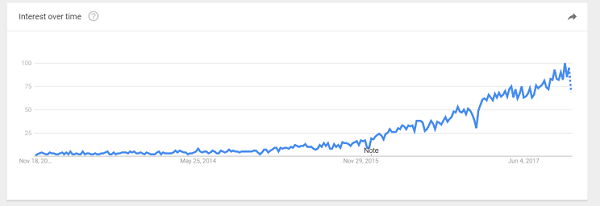
“Influencer marketing” is a tactic that has been on the rise for a while now. Over the last five years, interest in the topic has skyrocketed.

Social media has been a key factor in kicking this concept into high gear. Brands of all shapes and sizes now have a virtually unlimited amount of opportunities to pair with popular figures and connect with all sorts of new audiences.
The term “micro-influencer” refers to individuals who are highly passionate and knowledgeable in their field. In the eyes of their audience, which is typically less than 100,000, they are seen as trusted faces that can use their expertise to sway purchasing decisions.
Getting the ball rolling on a micro-influencer campaign is an exciting prospect. Not only is it a great way to expand your messaging, it’s a time when both parties involved have growth on their minds.
That being said, brand relationships with influencers should be approached with visions for the long-term. For this to work, managing campaigns needs to be done very diligently. Here are three useful tricks to ensure the process is done right.
Define key performance indicators (KPIs)
The first step of managing micro-influencer campaigns – or any marketing campaign – is defining your KPIs.
Without measurable goals and metrics that determine how well everything is running, gauging success is virtually impossible. Given the access to big data and all the technology involved in the modern marketing mix, there is no reason to leave any part of a campaign up to guesswork.
Start by laying out your overarching objectives. Then, pinpoint the numbers that will judge how well you are reaching them over a specific timeframe. Do you want to
- Increase followership on social media? By how much each month?
- Increase the number of unique visitors on your website? By how many?
- Boost sales? What’s the monthly or annual goal you’re shooting for?
Regardless of your objectives, having clearly defined KPI’s is critical in tracking the long-term feasibility of a campaign/partnership.
Set up an alert system
In any influencer campaign, one of your initial steps should be to set up a reliable alert system. This is one of the best ways to keep up with everything going on in relation to your own content, your partner’s content, the value you offer, and the overall insights related to your industry. Taking time out each day to catch up on all this information should be a priority. These alerts can serve a number of purposes.
For one, it gives you an idea as to what your target audience is buzzing about. This can be used as valuable inspiration for future content and collaboration ideas that benefit both you and your micro-influencer partner.
Second, a good system will give you an idea for how your strategy is resonating across the web. Are you getting more brand mentions? Are your brand’s relevant keywords trending across the search engines? Is your content seeing a spike in engagement?
Third, alerts can be extremely good warning signs. If you or your partner is getting negative sentiment or bad press, being notified in real-time can be a crucial factor in performing crisis management, if needed.
Gradually ease up on content guidelines
Micro-influencer marketing is like a relationship. There should be a certain degree of give-and-take.
In order to ensure a healthy, long-lasting relationship, you need to allow your partner to do things their way every once in a while. In fact, The State of Influencer Marketing report by Crowdtap found that 77% of influencers say that this is a deciding factor in choosing to work with a brand more than once.

In terms of managing a micro-influencer campaign, there can certainly be pressure in the beginning to produce content under strict guidelines. However, as time goes on, it can be very beneficial to give the influencer more creative freedom. If you stifle their authentic voice and tone, it can easily damage the integrity of both parties.
Giving up creative control can be a tough pill to swallow, especially if you are paying a pretty penny for the influencer’s service. Ideally, after a while, you will have built a strong relationship with the influencer to a point where you trust their knowledge of what works for their particular audience.
Fans aren’t stupid. Unauthentic content sticks out like a sore thumb. Social media never forgets mess-ups.
When it comes to content creation, communication should be a two-way road throughout. If you want a long-term relationship with a particular micro-influencer, their uniqueness needs to be a significant factor in your initial selection process.
In conclusion
Working with micro-influencers is great. The key to a mutually beneficial partnership is a strong degree of trust and coordination in working toward a shared vision.
Managing a campaign is not always an easy job. The way you conduct this process has a serious impact on everyone involved. As long as you keep a strong blueprint of goals and KPIs, consistently keep track of sentiment, and allow the creative juices to flow naturally, you should have a recipe for ongoing success.
Get the TNW newsletter
Get the most important tech news in your inbox each week.





